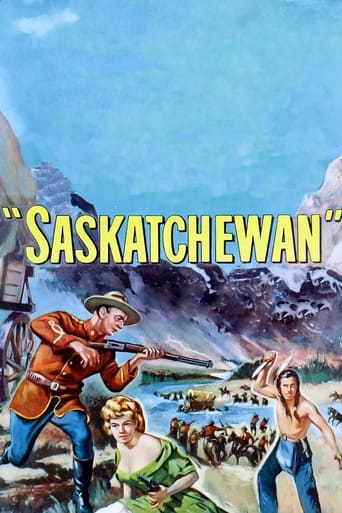

It's a mild crowd pleaser for people who are exhausted by blockbusters.
... View MoreI wanted to like it more than I actually did... But much of the humor totally escaped me and I walked out only mildly impressed.
... View MoreThis is a coming of age storyline that you've seen in one form or another for decades. It takes a truly unique voice to make yet another one worth watching.
... View MoreClose shines in drama with strong language, adult themes.
... View MoreSaskatchewan is well worth watching for the spectacular scenery and cinematography alone. But in fairness, the story and acting was above average for a 1950s Western, too. The plot has been done before and some of the dialog is cliché, but if you like a reasonable effort to show a balanced portrayal of both sides of the Indian/white conflict -- you should like this movie.If you liked Alan Ladd in Shane, you'll like him here, as well. Jay Silverheels, before he became Tonto, is his adopted brother. A young Shellie Winters and J. Carroll Naish add interest.I had to laugh at all the reviews complaining about the title and noting that the film was filmed in Banff National Park which is in Alberta, not Saskatchewan. They apparently did not read the introduction which clearly stated "Saskatchewan River Territory - 1877". At that time, neither Alberta nor Saskatchewan existed as Provinces. But the Saskatchewan River, then as now, begins in what is now Banff National Park.There were a number of other complaints about the anachronistic Mountie head gear worn in this movie. I suggest they send those letters to the retired Mountie Commander who was the technical adviser for the film. Surely, he should have returned his fee if they refused his advice on such a crucial matter (sarc).
... View MoreI was there on location for this film and it was filmed mostly in Alberta in the vicinity of Lake Louise and Banff. It rained a lot during the filming and a lot had to be redone at the studio. I was an extra and mostly rode horses and was a dead man in several scenes. As a kid it was a great experience.Alan Ladd was wonderful as was Carrol, Shelly and Raoul. They fed us well and we stayed in small out buildings, like motel buildings, near the Banff Springs Hotel. I had to leave early to do a film with Jeff Chandler and I had a commitment at the Pasadena Playhouse at that time also. My last theatre work was in 1960 when I had to give up show business for health reasons --- I needed to eat!Hope this clears up the question of where it was filmed.Don Alan (Droesch)
... View MoreSitting Bull and Crazy Horse vacationed in Banff. There are snow capped mountains surrounding Fort Walsh in SW Saskatchewan. The Mounties had a gun battle with the Sioux, leaving many dead on both sides. You can travel by canoe from the Rockies to Fort Walsh in a day (quite a feat considering it's hundreds of miles, and there's no river).It's all good. Indian scouts making jungle calls to each other at night. Mighty Alan Ladd slaying men left and right, winning the heart of the beautiful woman, and never having to raise his voice or change it from a flat, dull monotone. That's the kind of men the Mounties were made of.Best of all, Shelley Winters in a low cut dress, six gun in hand explaining "I was on my way to Battleford!"10/10
... View MoreNo, I've never been to the province. But a quick look at a relief map will show that all but the very southwest corner of Saskatchewan is prairie. Nevertheless mountains loom in the background in every shot of this film which is supposed to take place in the central part of the then-territory. The film is not alone in this; there are no mountains in western Oklahoma either, contrary to "True Grit." Alan Ladd plays O'Rourke, a RCMP officer with a progressive bent who must battle his mutton-headed commander as well as the Indians. Shelley Winters, here in her brief Marilyn Monroe-competitor period, is an American fugitive in a low cut dress. Unless you don't see many movies, you can probably surmise complications arising between the two. Jay Silverheels, later of "Lone Ranger" fame, is O'Rourke's Cree companion who angrily leaves him when the RCMP insist on confiscating the tribe's rifles and who must later confront his former friend. A previous post noted that the RCMPs are wearing "Smokey Bear", not the correct "sepoy" hats. More noticeable to me was the dress of the Indians, who always look to be gussied up for a powwow. Photographs of the time show that by the late 1800's Indians usually dressed in manufactured (i.e. white) clothes with a some Native touches. Common sense also makes me doubt leaders wore the heavy, conspicuous headresses into battle, although again this film is not alone in this. The plot involves the entry of the Sioux into Canada in the aftermath of Little Big Horn. In reality, the fragmented Sioux could hardly attempt a takeover of Western Canada, but merely hoped to find refuge from the vengeful U.S. Army. But here the setup is for a spectacular mass battle at the end, showing Indians charging en masse into white firepower the way they almost never did in actual history. Noticeably missing from depiction, by the way, are the Sioux women and children who trekked into Canada along with the warriors. Because of the spectacular backdrops in Technicolor, this is not too terrible an oater if only to see the conventions of the period.
... View More